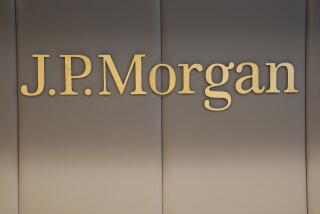In major policy shift, scores of FDIC settlements go unannounced

Three years ago, the Federal Deposit Insurance Corp. collected $54 million from Deutsche Bank in a settlement over unsound loans that contributed to a spectacular California bank failure.
The deal might have made big headlines, given that the bad loans contributed to the largest payout in FDIC history, $13 billion. But the government cut a deal with the bank’s lawyers to keep it quiet: a “no press release” clause that required the FDIC never to mention the deal “except in response to a specific inquiry.”
The FDIC has handled scores of settlements the same way since the mortgage meltdown, a major policy shift from previous crises, when the FDIC trumpeted punitive actions against banks as a deterrent to others.
The largest U.S. bank failures
Since 2007, 471 U.S. banks have failed, nearly depleting the FDIC deposit-insurance fund with $92.5 billion in losses. Rather than sue, the agency has typically preferred to settle for a fraction of the losses while helping the banks avoid bad press.
Under the Freedom of Information Act, The Times obtained more than 1,600 pages of FDIC settlements, made from 2007 through this year with former bank insiders and others accused of wrongdoing. The agreements constitute a catalog of fraud and negligence: reckless loans to homeowners and builders; falsified documents; inflated appraisals; lender refusals to buy back bad loans.
Defendants benefit by settling because they can avoid admitting guilt and limit the damages they might face in court. The FDIC benefits by collecting money without the hassle and expense of litigation. The no-press-release arrangements help close those deals.
Deutsche Bank, now the world’s largest, settled to resolve claims that subsidiary MortgageIT sold shaky loans to Pasadena-based IndyMac Bank, which imploded under the weight of risky mortgages and construction loans. The IndyMac failure — considered one of the early events that helped usher in the 2008 financial meltdown — caused a scene reminiscent of the grim bank failures of the 1930s, with panicked depositors lining up outside branches trying to reclaim their money.
Overall, the FDIC collected $787 million in settlements by pressing civil claims related to bank failures from 2007 through 2012 — a fraction of its total losses.
FDIC spokesman David Barr said the agency always tries to settle failed-bank cases before filing lawsuits and that it announces settlements only when damage payments are large and media interest intense. He declined to discuss the legal strategy behind the Deutsche Bank deal and other no-press-release agreements. A Deutsche Bank spokeswoman declined to comment.
Critics fault the government for going easy on banks in the aftermath of the financial crisis. At a Feb. 14 hearing, Sen. Elizabeth Warren (D-Mass.), founder of the Consumer Financial Protection Bureau, criticized FDIC Chairman Martin J. Gruenberg along with other bank regulators for their reluctance to make examples of Wall Street firms by taking them to trial.
Seeking to recover deposit-insurance losses, the FDIC has dealt mainly with smaller institutions that failed, unlike the big banks that were bailed out.
Attorneys who have represented bank officials and the FDIC said regulators are now far likelier to settle cases before filing lawsuits than after the last spate of failures, when more than 2,300 institutions collapsed in the 1980s and early 1990s, bankrupting a fund that insured savings and loan deposits. That crisis grew out of Reagan-era deregulation, which allowed thrifts already hurting from 1970s inflation to make riskier investments, including commercial real estate deals that soured en masse during the second half of the 1980s.
Critics describe the FDIC’s current practice of low-profile deal-making as a major departure from the S&L; crisis.
“In the old days, the regulators made it a point to embarrass everyone, to call attention to their role in bank failures,” said former bank examiner Richard Newsom, who specialized in insider-abuse cases for the FDIC in the aftermath of the S&L; debacle. The goal was simple: “to make other bankers scared.”
Newsom said he couldn’t understand the shift, unless the agency doesn’t “want people to know how little they are settling for.”
The FDIC should disclose as much as it can, said Lauren Saunders, managing attorney at the National Consumer Law Center in Washington. “Transparency is always better, and serves as a deterrent to future misconduct.”
Barr says attorneys representing the FDIC make clear to the defendants that, although it will not publicize settlements, it also cannot legally keep them secret.
The ban on secret settlements was a provision in one of the laws passed after the S&L; crisis. Although the measure doesn’t require the FDIC to call attention to settlements, nondisclosure agreements like that with Deutsche Bank violate “the spirit of the law,” said Sausalito, Calif., attorney Bart Dzivi, a former Senate Banking Committee aide who drafted the provision.
Many of the FDIC settlements reviewed by The Times are small, but others required larger payments from prominent lenders. Quicken Loans and GMAC’s Residential Capital unit, for example, separately agreed to pay $6.5 million and $7.5 million, respectively, over soured loans they had sold to IndyMac.
A ResCap spokeswoman declined to comment. Quicken Loans spokeswoman Paula Silver expressed surprise that the settlement became public, saying officials at the lender had believed that would not occur. “Quicken Loans and the FDIC entered into a ‘confidential’ agreement nearly three and a half years ago which clearly states that no party admits liability nor wrongdoing,” Silver said in a statement.
At least 10 undisclosed settlements involved officers and directors accused of contributing to the collapse of their own banks. Those include 11 insiders at Downey Savings & Loan in Newport Beach who paid a total of about $32 million, most of it covered by corporate insurance policies. In the Downey case, the FDIC announced last year that four of the insiders had agreed to be banished from banking, including Maurice L. McAlister, Downey’s co-founder, who died Feb. 13.
But the announcement mentioned nothing about the payments or sanctions against the seven other former insiders. Out of the $32 million, McAlister was required to pay $1.93 million out of his own pocket, with the other insiders paying a combined $1.75 million. Insurers that provided coverage for civil wrongdoing by officers and directors paid the remaining $28.4 million.
The FDIC also has resolved certain claims involving IndyMac, including a $1.4-million settlement in May 2011 with the thrift’s former president, Richard Wohl. The agreement, filed as part of a complex corporate bankruptcy case, had gone unreported until December, when the agency provided it to The Times in response to questions.
The FDIC has recently stepped up the number of lawsuits against bank insiders. Century City attorney Jeffrey A. Tisdale, whose firm represents bankers, said the trend reflects insurers pushing back against FDIC demands that they settle claims for the policy maximum.
Insurers for bank directors and officers are saying, “We really are not an ATM machine for you, the FDIC,” Tisdale said.
The FDIC also may have been emboldened by success in a rare case it took to trial, according to a recent report from consulting firm Cornerstone Research.
The trial led to a Dec. 7 federal jury verdict in Los Angeles ordering three former IndyMac executives to pay $168.8 million for what the FDIC said was reckless approval of 23 loans to developers and home builders who never repaid them. It was the highest award possible in the case.
Another FDIC lawsuit, seeking $600 million from former IndyMac Chairman and Chief Executive Michael Perry, was resolved for a fraction of the claim Dec. 14. Perry agreed to pay $1 million himself, allowed the FDIC to pursue an additional $11 million from insurers and agreed to be banned from the industry.
The news was first announced in emails sent to news organizations — not by the FDIC, but by Perry’s defense attorneys, who considered the outcome a victory.






